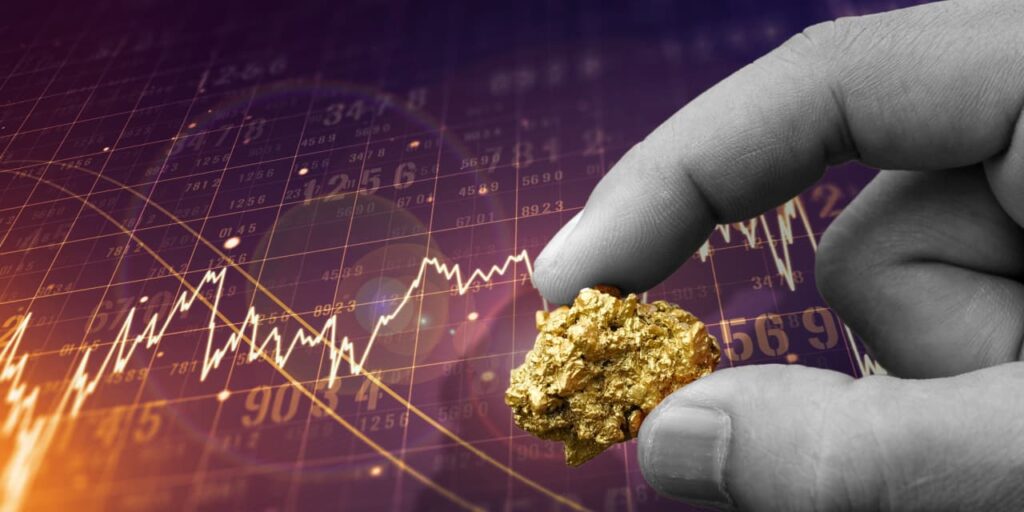Gold’s rise to record-high prices does not mark an end to opportunities in the precious-metals market as analysts continue to tout the benefits of gold in a broader investment portfolio.
The metal has reacted to a significant weakening of the U.S. dollar and a sharp fall in U.S. Treasury rates from their recent 5% highs, said Jeff Klearman, portfolio manager at GraniteShares. Gold has also benefited from growing expectations the Federal Reserve will cut interest rates in the first half of next year, the geopolitical uncertainty surrounding Ukraine, the Middle East and China, and increasing “consciousness of the possible effects of the large and every-growing U.S. national debt.”
“These factors are likely to remain supportive of gold prices going forward,” Klearman told MarketWatch.
Gold futures prices
GC00,
GCG24,
climbed to as high as $2,152.30 an ounce on Sunday evening, the highest intraday price on record, according to Dow Jones Market Data. They posted an all-time settlement high on Friday at $2,089.20. So far this week, however, prices have eased back — trading roughly 2.5% lower.
Sentiment in the sector has “become optimistic, which is often followed by consolidation,” said Tim Hayes, chief global investment strategist at Ned Davis Research. “Gold has started to pull back, and we can’t know how long this will last.”
Even so, “watch for signs of stability and then view the first signs of rallying as a buying opportunity,” said Hayes.
He believes that for most investors, a gold-specific exchange-traded fund would be the best way to gain exposure in gold.
The SPDR Gold Shares ETF
GLD,
is the world’s largest physically backed gold ETF, with gold holdings valued at $57.3 billion, as of Dec. 5.
As of Dec. 4, the GraniteShares Gold Trust
BAR
had a total value of gold holdings of $946.3 million, while the Sprott Physical Gold Trust
PHYS
had a total net asset value of $6.42 billion.
Physical gold ETFs provide a “transparent and liquid investment platform, providing pure exposure” — with the exception of a “slight drag due to adviser/sponsor fees” — to the value of gold on a real-time basis, said GraniteShares’ Klearman. “Investing prudently and over time…as done with other asset classes is a reasonable approach.”
Read: Gold prices are surging — what ETF investors need to know before adding some shine to their portfolios
Ryan McIntyre, managing partner at Sprott Inc., said that investors wish to take on more risk, gold equities could be added as a “supplement to physical gold holdings.
That would be “considered a more aggressive option in a gold allocation, aiming to offer leverage to gold prices and the potential for high returns, albeit with increased risk levels,” he said. Sprott has both an ETF — the Sprott Gold Miners ETF
SGDM
— and a mutual fund, the Sprott Gold Equity Fund Investor Class SGDLX.
Both would “fit the bill as offering broad exposure to gold mining equities,” said McIntyre, who’s also senior portfolio manager at Sprott Asset Management.
Sprott believes that 10% of an investor’s portfolio “always should be allocated to physical gold,” though typically the “more conservative options in gold allocation,” McIntyre said. Physical gold provides a “store of value and hedge against systemic risks.”
Meanwhile, Peter Schiff, chief economist and senior markets strategist at Euro Pacific Asset Management who has, for more than a decade, expected a climb in gold to $5,000 an ounce, pointed out that gold mining stocks performed poorly in the last 10 years. “If we get a meaningful rise in gold, there is tremendous upside potential for gold mining stocks.”
The NYSE Arca Gold Miners Index, which tracks the performance of companies in the gold-mining industry, is up more than 5% higher this year, after posting declines of more than 10% in each of the last two years.
Gold prices may still be in for more declines before making moves to fresh record highs.
In a note dated Tuesday, Solita Marcelli, chief investment officer, Americas, at UBS Global Wealth Management, suggested that in the short term, investors should “avoid chasing the rally in gold.”
The immediate upside for the metal remains limited as markets have gone too far in pricing in a “swift run of rate cuts from the Fed next year,” safe-haven demand for gold from geopolitical risks could become “less pronounced,” and a further rise in gold would likely require inflows into ETFs, she wrote.
““We think a percentage allocation [in gold] of around mid-single digits is appropriate within a balanced portfolio.””
Still, UBS raised its gold price forecast by $100 an ounce and said it now sees prices trading as high as $2,250 per ounce in a year’s time.
“Gold performance in the wake of the Israel-Hamas war supports our view of its importance in long-term portfolios, and we think a percentage allocation of around mid-single digits is appropriate within a balanced portfolio,” Marcelli said, with UBS favoring added exposure to gold on dips below $2,000.
Read the full article here



